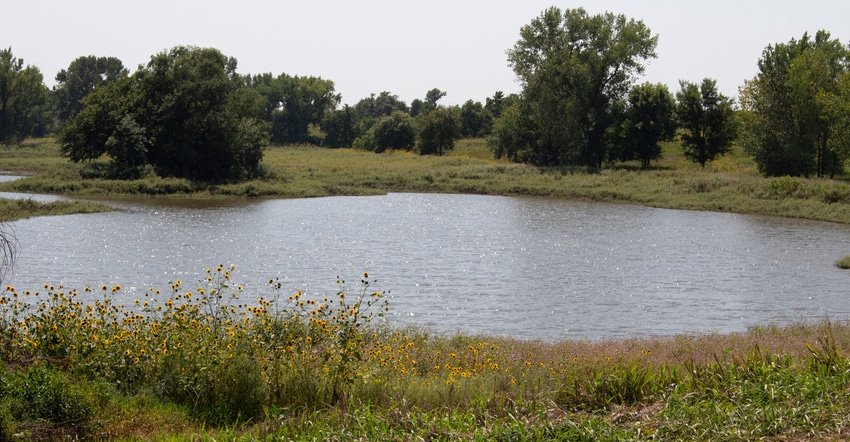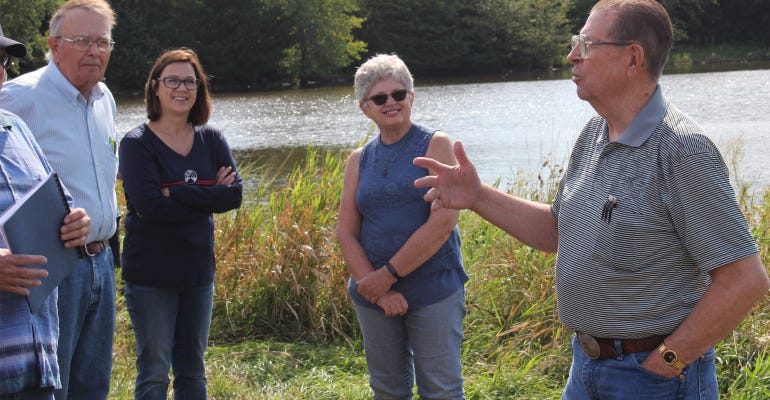September 28, 2020

The water in the pond on Dwaine Kubicek's farmland in Milligan, Neb., is low, having been drained recently for improvements to the dam structure. Still, bullfrogs are hopping, cicadas are singing, and a family of ducks is paddling across the pond toward the haven of a small island.
Trees hug the shoreline, providing cover for white-tailed deer and mule deer. Kubicek has seen plenty of bobcats, rabbits, pheasants, quail and numerous species of waterfowl at the communal watering hole.
In spring, dozens of endangered whooping cranes will pause their annual migration for a short stay on the property, filling up on last year's corn in the neighboring fields and bedding down on the water at night.
This ecosystem is made possible by the dam on the north end of the pond. Originally installed by Kubicek's father in 1964, the dam collects runoff from 1,600 surrounding acres and holds 78 acre-feet (25.4 million gallons) of water in the conservation pool.
After 56 years of use, the dam still was functional but had begun to show its age. Parts of the tube were rusted through. Kubicek knew water seeping through the pipe could wash out the soil underneath and lead to the dam's eventual failure.
"I didn't want to just break it open and not catch all that water," Kubicek says. "I wanted to keep that conservation practice going."

DAM TOUR: Dwaine Kubicek visits with members of the NRD board of directors and staff about the value of the dam on his property in August 2019.

Kubicek partnered with the Upper Big Blue Natural Resources District on the repairs, taking advantage of cost-share funds in the Private Dams Program. These funds provide landowners with an opportunity to correct or rebuild privately owned dams.
The NRD will contribute 75% of the project costs up to a maximum cost-share of $50,000. Eligible costs include construction and design services provided by a private engineering firm. The NRD works with USDA's Natural Resources Conservation Service for the design and construction support services provided to this popular program.
The repairs to Kubicek's dam, which included removing the old pipe and installing a new one, as well as a new riser and other reinforcements, cost about $71,000, of which the NRD contributed $50,000.
"When my dad built it, it cost $10,000. Now just to replace the tube is over $70,000. But I guess that's progress," Kubicek jokes. "I was most appreciative that the Upper Big Blue decided to help me out on that because it would have been a much bigger decision for me otherwise."
Nebraskans have made a large investment in building dams across the state. There are more than 2,900 dams on the Nebraska Dam Inventory; 57% of them are privately owned. Most of these dams are considered "small" (storage of 15 to 250 acre-feet).
According to a report from 2018, 43% of Nebraska's dams are more than 50 years old, and nearly 500 Nebraska dams are in poor condition, meaning they may fail under expected conditions. To rebuild these dams (at an average cost of $60,000 each) the total investment would be $122,820,000.

AERIAL VIEW: An aerial shot of Dwaine Kubicek's place in Milligan, Neb., in July 2019. The dam structure provides many benefits on the farm.

Dams such as Kubicek's provide sediment and erosion control. They also control flooding and store water for future irrigation use. Water that would have been lost instead stays on Kubicek's land and recharges the aquifer. Kubicek is considering the installation of a second dam on another part of his property for additional flood control.
After the flooding Nebraska saw in 2019, Kubicek isn't the only one who recognizes the value of dam investments. Across the state, the flood control benefits of Nebraska's dams provide an estimated benefit of more than $62 million per year.
The work on Kubicek's dam was completed in August, and with the rainy week at the beginning of September, the water level was on the way back up. One of the final components to the project was reseeding the area that had been damaged by work crews and heavy machinery with native grasses to prevent erosion and restore the wildlife habitat.
Kubicek stocks the pond annually and says the fishing and hunting at the dam site both are good. "There are six of us eating off of that area," he says. And that, in addition to the many other benefits, is an investment worth protecting.
Learn more at upperbigblue.org or by calling Jack Wergin, project department manager at the Upper Big Blue NRD, at 402-362-6601.
Houston is public relations manager at the Upper Big Blue Natural Resources District.
Source: Upper Big Blue NRD, which is solely responsible for the information provided and is wholly owned by the source. Informa Business Media and all its subsidiaries are not responsible for any of the content contained in this information asset.
You May Also Like




